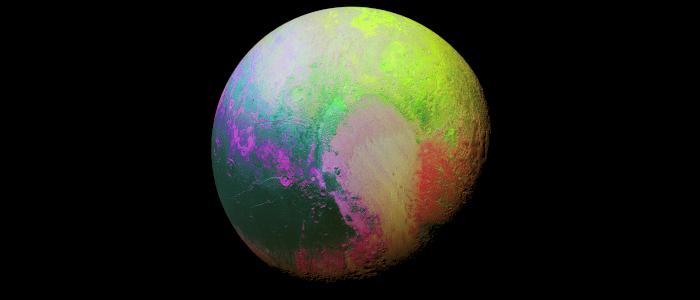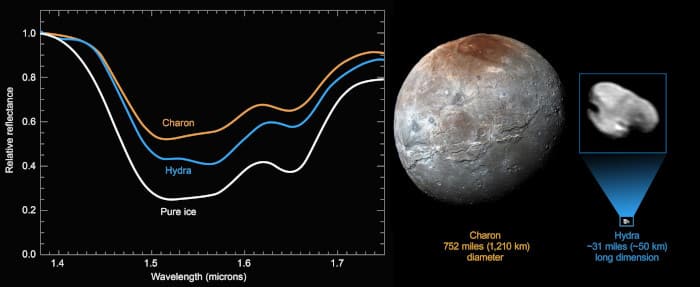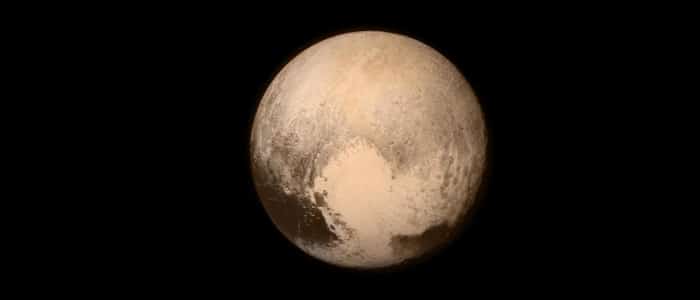Pluto was discovery was more of an accident than an accurate prediction based on mathematical calculations based on a model. This took place on February 18, 1930, in Flagstaff, Arizona, by an amateur astronomer, Clyde Tombaugh. He discovered it in the constellation Gemini.
While it was once the ninth and smallest planet in our solar system, that all changed in 2006 when the International Astronomical Union reclassified it as a dwarf planet. The planet declassification came about when astronomers discovered that it was a fairly large object among the field of ice and debris known as the Kuiper belt.
What Is A Dwarf Planet?
A Dwarf planet is a much smaller celestial body that orbits the sun. It is round in appearance like a planet but is “not able to cleat its orbital path so there are no similar objects at roughly the same distance from the sun. (NASA)”

Astronomical & Atmospheric
Pluto has a radius of 736.32 miles, an orbit greater than Neptune’s, and is atypical in a few different ways. It is more inclined and more elongated, or oval than any other planetary orbit, just to name a couple. It rotates in retrograde in 6.39 Earth years at a speed of 2.93 miles per second.
This dwarf planet exists at a distance of 3.7 billion miles away from the Sun. It takes approximately five hours for sunlight to reach it and in turn, the surface temperature is so cold that the nitrogen and carbon monoxide present is in the form of ice.

The atmosphere was only discovered in 1988 and is made of predominantly nitrogen but also contains concentrations of carbon monoxide, methane, and hydrogen cyanide. The New Horizon Mission found additional components to the atmosphere. These additions include acetylene, ethylene, and ethane.
Pluto is locked in step with Neptune with Pluto orbiting the Sun two times for every three orbits around the Sun that Neptune makes.

Moons
There are five known moons. The biggest one is Charon which is half as big as Pluto and is in synchronous rotation with it. It was discovered in 1978 through telescopic images of Pluto.
Both Charon and Pluto orbit around a common point and have the same rotation period. Charon is more neutral in color and less reflective than Pluto. Its surface contains organic compounds and silicates. It also has patches of ammonia in some of its impact craters.

The other four moons are smaller than Charon and rotate asynchronously with Pluto. They are all elongated and revolve in a circular orbit. Hydra is the most reflective of them all and has an orbital radius of 40,216 miles, Kerberos’s radius is 35,884 miles, followed by Nix at 30,254 miles, and lastly, Styx has an orbital radius of 26,354 miles.
The discovery of these four small moons was made through images provided by the Hubble Space Telescopic. The photographic discoveries of both Hydra and Nix in 2005, Kerberos in 2011, and Styx in 2012

What Color Is Pluto?
Pluto is for the most part different shades of a reddish brown that comes from the combination of surface methane and ultraviolet light.
What Is Pluto Best Known For?
Pluto is best known for, at one point, being the ninth and smallest planet in our solar system and later being removed from the classification of planets and reclassified as a dwarf planet.
What Time Will Pluto Return?
The United States historically has a transformative change when Pluto returns every two hundred and forty-eight years. This is happening in the year 2022. During this year Pluto will return to the exact location it was in when the United States Declaration of Independence was signed on three different dates. The dates that it has already and will return are February 22, July 11, and December 28.

What Planet Rains Snow?
Pluto was discovered in 2016, by the New Horizon’s Mission, to have mountain ranges covered with snow and ice. Likewise, Venus, Saturn, Jupiter, and Neptune also have snow and ice storms.

Does Pluto Have Storms?
This dwarf planet does have windstorms that redistribute the ice that covers its surface terrain but it doesn’t have the immense storms of some of the other planetary bodies.
How And When Did Pluto Get Its Name?
In 1930, an eleven-year-old girl named Venetia Burney, from Oxford England, suggested the name for the planet when it was newly discovered. Her suggestion was then forwarded, by her grandfather, to the Lowell Observatory where they later selected Pluto as the name.
The Wrap Up
In conclusion, I have very much enjoyed my time exploring Pluto and finding out some new information that was not previously known, to me anyway. I am sure I will revisit this dwarf planet at some later point in time. Until then, I hope you have enjoyed it as well.
If you have learned something new or exciting, please let me know in the comment section below.
There is so much more that remains unknown in both space and time. I will keep exploring the possibilities and sharing my experiences with you here.
This post contains affiliate links. Learn more and read our full disclosure policy here.

If you have any questions about Astro Explorations or if you have any comments that you would like to share, feel free to leave them down below and I will get back to you as soon as possible.
Disclosures & Policies
All Images Are Courtesy of NASA
References
Encyclopedia Britannica. (2022, August 04). Pluto. Retrieved from Encyclopaedia Britannica: https://www.britannica.com/place/Pluto-dwarf-planet
NASA. (2011, September 02). ScienceCast 26: Visit to Pluto. Retrieved from NASA: https://images.nasa.gov/details-26_VisitToPluto
NASA. (2015, October 23). Family Portrait of Pluto Moons. Retrieved from NASA: https://images.nasa.gov/details-PIA20033
NASA. (2016, May 6). Icy Hydra. Retrieved from NASA: https://images.nasa.gov/details-PIA20581
NASA. (2017, December 08). Pluto and it’s moon Charon Shine in False Color. Retrieved from NASA: https://images.nasa.gov/details-GSFC_20171208_Archive_e000683
NASA. (2017, July 14). Soaring over Charon. Retrieved from NASA: https://images.nasa.gov/details-PIA21864
NASA. (n.d.). New Horizons. Retrieved November 3, 2022, from NASA: https://solarsystem.nasa.gov/missions/new-horizons/in-depth/#:~:text=New%20Horizons%20is%20a%20NASA,50%20AU%20from%20the%20Sun.
NASA. (n.d.). What Is A Dwarf Planet? Retrieved November 3, 2022, from NASA: https://d2pn8kiwq2w21t.cloudfront.net/original_images/infographicsuploadsinfographicsfull11268.jpg


It is surprising to know that Pluto was a result of accidental discovery. Although I always know it’s quite some distance to the sun but never knew it could stretch as far as 5 hours for the sun to reach Pluto and rotate with four moons. Thank you for taking out time to highlight these essential details like the sizes of the moons
Hello Parameter,
There is so much that we still do not know about space and what is out there. I like the discovery of new things and the exploration fascinating. I hope that you will come back to explore again.
Have a wonderful day!
This is a very fascinating and interesting review about this planet. It is very enlightening to know some important facts about this planet. Sometimes one would wish that some of these planets were habitable humans. Anyways thanks for sharing such an interesting piece of review here as it was really helpful.
Hello Apexvilla,
Thank you kindly for your attention and encouragement. I am on the path to exploring some Exoplanets that may be candidates for habitability. I am looking forward to what I find.
Have a wonderful day!
I am a HUGE fan of space and space exploration and even though I’ve read articles on Pluto before I loved reading every word of this article.
It seems like every time I read an article about one of our planets or space I learn something new, such as the winds and atmosphere composition of Pluto here.
I can’t wait until we can start learning more about our solar system from the amazing efforts of SpaceX, Blue Origin, NASA, and all the other entities around the globe pushing us to a further beyond!
Hello Mark,
Thank you for taking time to read this article. It is appreciated.
I am also looking forward to what SpaceX and NASA discover next. I think we will learn a lot from the James Webb Space Telescope as well. It has way more powerful capabilities than even the Hubble Telescope. And I love the vivid details that JWST shows in their images of space.
I hope to run into you again through my explorations.
Merry Christmas / Happy Hanukkah & Happy New Year To You & Yours.
Have a wonderful Holiday Season!